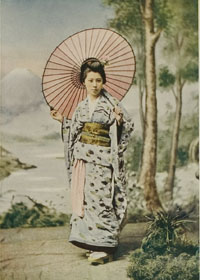summer kimono
the color of blue sky...morning pilgrimage (Kobayashi Issa, 1822)
June 22–September 8, 2008

George Waldo Browne
Japan, the Place and the People
Few items evoke Japan in the Western imagination more than a kimono. Although literally translated as “what is worn,” the kimono is far more than a utilitarian garment. Replete in symbolism in cut, color, and ornament, the finest kimono are unique works of art.
The Meiji era (1868--1912) produced the elegant kimonos that are most familiar today. The overthrow of the Shogunate and the return of the Emperor brought the end of sumptuary restrictions and raised the status of the merchant class. These factors combined to bring a surge in the demand for and production of luxurious, custom-made kimonos.
This period also marks Japan’s first prolonged contact with the West. The spread of Western technology, mores, and customs across Japan resulted in an increased national pride in certain quarters. This manifested itself in the conspicuous display of the very Eastern kimono and a rejection of Western-style dress.
The flow of cultural influence worked two ways. Photographic books created specifically for foreign consumption and the exportation of Japanese goods, particularly textiles—and kimono—fueled the fascination with all things Japanese, leading to the widespread Japanisme that flourished in both the fine and decorative arts..
All of the works shown are from the Sterling and Francine Clark Art Institute Library.
Japanese kimono designs
Publication information unknown
From the Mary Ann Beinecke Decorative Art Collection.
Many decisions went into the commissioning of a new kimono. Fabrics and colors had to be chosen, generally based on the season and the age of the wearer. The selection of the overall motif was key to establishing the aesthetic statement the wearer wished to express. Kimono makers made available to their clients catalogs of themes offered by various workshops, as are represented in these two volumes.